By Jeffrey A. Rendall; Images Courtesy of Nike Golf
|
|
BEAVERTON, OR – Louis Sullivan, widely considered America’s first truly modern Architect, is probably most famous for coining the phrase ‘form ever follows function,’ the notion being a building’s purpose should guide its design.
The same concept applies to modern improvements in golf equipment design as well, perhaps best demonstrated by a relative newcomer to the professional and consumer golf markets, Beaverton Oregon’s Nike Golf. Ever since bursting onto the scene in 1999, Nike’s blazed significant inroads into the eternally competitive golf manufacturing industry.
One way Nike’s achieved success at such an early ‘age’ is its ability to produce products that people seem to be able to relate to – the ‘form’ follows the ‘function,’ in other words.
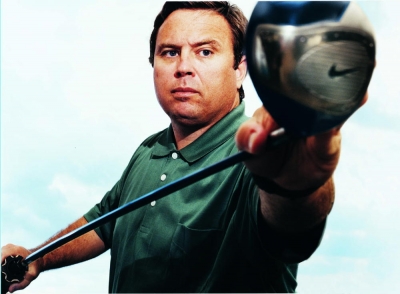 |
| Nike Golf's Club Guru, Tom Stites, with one of his creations. |
It also certainly hasn’t hurt that Nike inked an early endorsement deal with perennial world #1 Tiger Woods (before he even hit a professional shot – how’s that for taking a chance and reaping the benefits?). But it’s much more than Woods that makes this company different. Establishing an emphasis on quality early, Nike hired some of the best talent in the business, and they’ve come up with a plethora of truly unique and inspired products.
It might be fun to watch Tiger and his talking head cover ‘Frank’ banter back and forth on those TV commercials, but beyond the marketing, there’s a serious level of technical know-how at Nike. Not bad, considering the company first introduced products only five years ago.
Tom Stites, Nike Golf’s Director of Product Creation, Clubs (and self-described ‘club geek’), tells the story of how Nike Golf’s equipment division came to be: “I first got into making golf clubs in the mid-80’s, working for Mr. Ben Hogan. That was an incredible stroke of luck to learn in that way, because Hogan heavily emphasized quality. Then I began consulting for a large number of other companies over the years, and met a lot of great folks along the way.”
Stites continues, “Then one morning I woke up and it looked like there were four, five, six of those people I’d known for a long time working at Nike, starting to assimilate into a golf equipment design team, doing golf balls and that sort of thing. Then, when they decided to look into introducing their own line of clubs, because of my past consulting experience with them, we started exploring.”
Explore they did. Nike decided it needed Stites’ full team of five people to become the core for research and development on its club division, and the rest is history. Because of Stites’ background and success in designing products for many of the industry’s ‘name’ companies, it immediately gave Nike a credibility and presence on the world’s professional Tours – not to mention it took him and his team off the market.
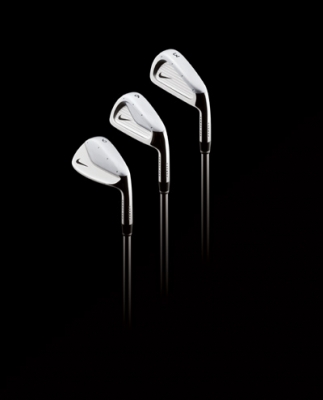 |
| Nike's Pro Combo Irons. |
Stites was a freelancer no more, but giving it up to work for Nike couldn’t be all bad. He said Nike’s first mandate was to design world-class golf clubs that the best player(s) in the world would find attractive. As a result, a prototype forged blade was developed – and subsequently used by David Duval to win the British Open in 2001.
But the ‘big’ guy didn’t make the irons switch ‘til 2002, and has yet to fully adopt a complete compliment of Nike clubs in his bag. Woods recently converted to the company’s new Ignite driver, however, and he’s working with Stites and the design team on many of its club-making ideas and concepts.
“We’ve got a philosophy – to produce the highest possible quality level for our professional players, the people who are extremely blessed with talent. That was our first objective, to establish credibility,” Stites said. “The follow-up shot was developing clubs that average people can use and have fun with, and improve their games. That first became reality with the Pro Combo irons, which I’d say were just a step away from the extremely good players’ clubs, which were the forged blades we developed first.”
The final piece in the consumer puzzle being the new ‘Slingshot’ irons, which are all the rage right now (don’t you love the commercial with Tiger, ‘Frank’ and Charles Barkley?). For purposes of this review, we’ll concentrate on the Pro Combos, since those are the ones we tried last year.
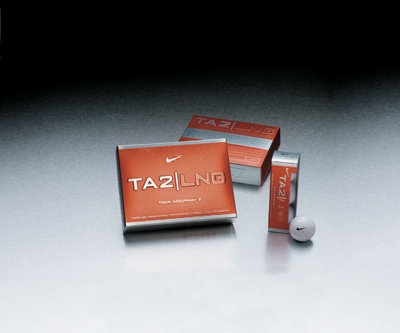 |
| Nike's TA2 LNG Golf Balls. |
The Pro Combo concept was interesting from the start, because it seemed to incorporate game improvement features with ‘feel’ clubs, all in one set.
Again, Stites tells the story: “Back when my group was independent, we struggled to define what kinds of clubs people should be playing with – from Tour professionals down to mid-handicappers. So, we ended up building three sets of irons – a blade, what we call a half-cavity (slight game improvement), and then a game improvement iron.”
“Three sets of clubs, 27 in all. And when we started testing people, trying to find out what worked best for each individual, we found the identical sets were getting mixed up. People said ‘I like this design in the long irons, this design in the mid irons, and this one for the short irons,” Stites said.
As a result, the Pro Combo concept was born. When the Stites team moved over to Nike, they brought the idea with them and honed it over the next several years, until the Pro Combo irons were introduced last year (2003). They’re kind of a ‘classic’ hybrid, since they all look the same at the address position. Only in the bag or on the rack do they look like a hybrid set.
Stites said the rationale for different types of irons makes sense: “When you think about it, the two-iron shot is a totally different kind of golf shot than an eight-iron shot. So why should we have ever presumed, like we did for a hundred years, that a set of golf clubs had to match identically in terms of design?”
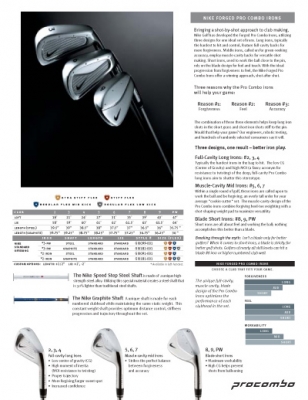 |
| The stats only tell part of the story with the Pro Combo Irons. |
Some other assumptions bit the dust with the Pro Combo irons – the most important being the belief that you can’t make a forged club that’s forgiving. Coming from the Ben Hogan philosophy, Stites was familiar with forged clubs, and that experience carried over to his workings at Nike.
“Great players have a perception and feel for equipment that average people don’t, and they’ve always tended to stick with forged clubs,” Stites expounded. “It’s a little bit like music. The best players are like musicians who have the ‘ear’ and can just flow into music, while the rest of us having to kind of just learn on the piano and plunk things out.”
But the modern forging process is bringing beautiful music to more ears, I’m happy to report.
“Forgings used to be more limited in terms of what you could design for game improvement, because the manufacturing methods were essentially hammer and chisel blacksmith technology. Up until five, ten years ago, forged clubs were very difficult to make,” Stites explained.
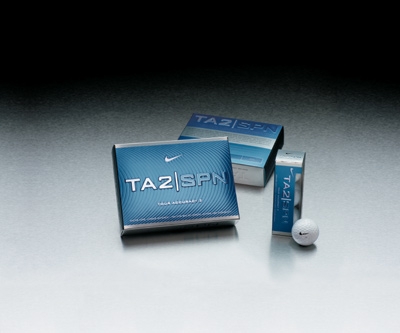 |
| Nike's TA2 SPN Golf Balls. |
“Castings had more appeal because you could put in more exotic shapes and distribute the weight a lot more. That’s changed in the last few years, and now we can manufacture precision forgings with some pretty significant game-improvement mass distributions. So we decided that that was a great way to start in the club manufacturing business – to produce high quality forged clubs like the Pro Combo and our blades,” Stites said.
Again, it’s form following function. Maybe that’ll be the next Nike marketing slogan.
But it’s more than just irons where Nike’s developing some unique products. They sent me a representative of their newest putter lines, the ‘Oz’ model of Blue Chip Putters. Picture a traditional putter blade – but with a mini-model of the St. Louis arch attached to the back. ‘Wild’ fits well, or as I’ve been known to call it, ‘Space Age.’
“People didn’t realize when we introduced it, but if you look at the Slingshot iron, which has the bar running across the back – the Oz putter was the very first Slingshot, even though we didn’t call it that way,” Stites said. “It’s the same technology, but applied to a putter – and it’s really a pretty unique and very nice performing putter.”
The technology part having to do with fixing maximum amounts of weight on the toe and heel – in order to resist twisting, every putter’s natural enemy.
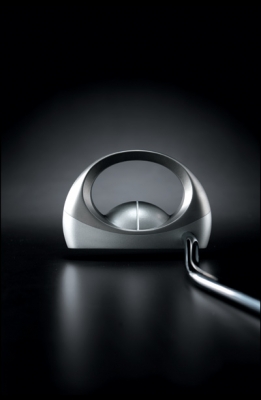 |
| Somewhere over the rainbow, the Oz putter helps you make putts. |
Stites puts it more practically: “If you’ve got a little red wagon full of rocks, it’s easier to pull that wagon than it is to push it. So the more you can position the center of gravity behind the connection point to the shaft, the easier it is to keep it square and straight coming through the stroke.”
“The same story applies to the Slingshot irons, when we put the weight behind the face of the club. It allows the face to shut easier and be pulled though the shot in a more square position. As Martha Stewart would say, ‘it’s a good thing,’” Stites added.
A jury might've found Martha Stewart guilty, but Stites’ ‘good thing’ really works with the Oz putter. Always a bit skeptical with something as bizarre looking as the Oz putter, the form follows the function again, if the purpose is to make putts. The Oz was very easy to line-up, and the keen center-of-gravity got the ball rolling. That’s about the most you can ask for from a putter.
Likewise, I found the Pro Combo irons live up to their player-friendly billing. I especially liked the looks of them – very sleek and tight at address. Having grown into golf using forged clubs, it was a bit of memory time-warp to the old days. The heads are smaller than some of the contemporary cast models, so it took some time to get used to.
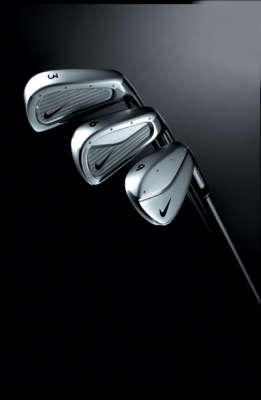 |
| You can see three distinct club types in the Pro Combo Irons. |
The thing that strikes me about forged clubs – if you hit the ‘sweet spot,’ you understand exactly how that point on the clubface got its name. It’s sweet, indeed – you barely even feel it. Combined with a soft golf ball, it’s all the touch and feel you’ll need to let your talent take you where it’ll go.
I’d say from a subjective standpoint, the Pro Combo long irons were a bit less forgiving than some of the larger headed game improvement irons I’ve used, but the excellent feel derived overall from the clubs makes them worth it, well suited for your better average players (and low handicappers) with talent to ‘grow’ into a forged golf club.
I was fortunate enough to try out the clubs with some of Nike’s golf ball products – The TA2 LNG (Long) and TA2 SPN (Spin), as well as the Power Distance line (Super Soft, Super Fly and Super Far). From personal preference, I’d recommend the TA2 SPN over the others, simply because it had the distance and feel I’d expect from a premium golf ball -- not that the others didn’t, I just preferred the SPN. Most of Nike’s Tour staff prefers either the TA2 LNG or newer Nike ONE ball, it should be noted.
It is amazing that even in the lower priced Power Distance brands, just how far Nike’s come in such a short time. The golf ball market is extremely competitive, and if you’re not producing a quality product at the right price, you’ll be passed by easily. Nike competes favorably at the high-end with the ONE ball, and at the consumer end with its Power Distance group. Simply put, people have choices.
Stites and the others will make sure you continue to enjoy viable options at Nike. “We love competing every bit as much as Tiger Woods does. We love the game of golf, and it’s fun doing what we do. But you know, this is a business, and we’re going to work very hard to become a major player in it.”
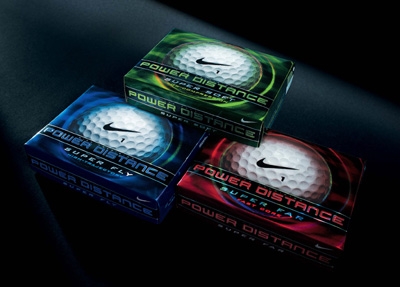 |
| The Nike Power Distance Golf Balls -- solid performance for a solid price. |
If form follows function, its success says Nike Golf’s already there.
Details:
Nike Golf’s Pro Combo Irons, Blue Chip Putters, TA2 and Power Distance Golf Balls
Available at your higher-end golf retailers and club pro shops.
| Related Links | Comments on this article? | |
|
Maryland National Golf Club Hollow Creek Golf Club Rocky Gap Resort PB Dye Golf Club in Ijamsville Whiskey Creek Golf Club |
E-mail Jeff Rendall, Editor: jrendall@golftheunitedstates.com |













